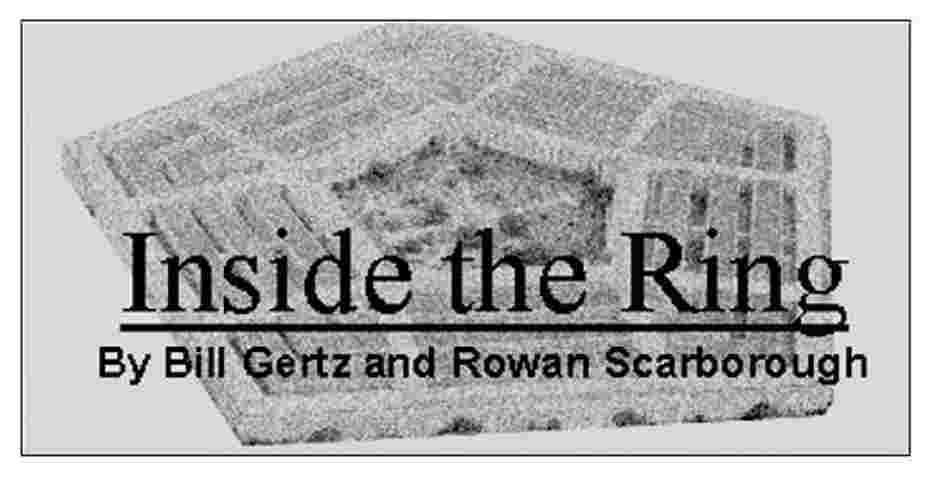|
Return to
|

|
June 18, 2004
Notes from the Pentagon
North Korea test
A U.S. official said the test was detected in the past two months at a facility near Musudan, along the northeastern coast about 120 miles from the border with Russia, and might have been part of Pyongyang's efforts to develop the long-range Taepo-Dong 2 missile.
The official said it is unlikely that the engine test was intended to influence the six-party talks on North Korea's nuclear program, which took place around the time of the test. The "static ground" test also did not break Pyongyang's self-imposed moratorium on flight tests.
The official confirmed the test after the South Korean newspaper Joongang Ilbo reported it last week.
The Taepo-Dong 2 was first tested in August 1998 and is believed to have enough range to hit the United States. North Korea is believed to have constructed at least four nuclear warheads.
The new missile is the main reason that the United States agreed to speed up development of a ballistic-missile defense system in Alaska and California, which is expected to be operational in October.
Trade-offs
He said the Office of Reconstruction and Humanitarian Assistance (ORHA) did not get organized until weeks before the March 2003 invasion.
"There were various ... diplomatic reasons that that office was not created until after Saddam made it clear he wasn't cooperating with the inspection regime," Mr. Feith said in an interview.
"What it meant was the office didn't get created until late January and then the war began in March, so it didn't have that much time to do its work. And a number of people have pointed out, which we all knew, that had that office been created months before it could have done its work better. Everybody knew that," he said. "But also everybody knew that there was a danger if one created that office early that you could be undercutting the diplomacy that was aimed at trying to solve the problem without war. So there were trade-offs."
Mr. Feith tells us that the Bush administration is likely to authorize a standing task force that would plan for such stability missions instead of creating them ad hoc.
MDA honors Reagan
"President Reagan's vision of a world where effective defenses against ballistic missile attack could protect the American people and people around the world is being realized through the dedication and hard work of thousands of military, civilian and contractor personnel throughout the country," the agency said in a statement.
"President Reagan knew that American minds, technology and hard work could solve the many scientific and technical challenges involved with fielding effective missile defenses."
Building missile defenses is not without challenge.
The MDA said it shares Mr. Reagan's optimism and confidence when he said free people can "live secure in the knowledge that their security did not rest upon the need to instantly retaliate against a missile attack, that we could intercept and destroy ballistic missiles before they reached our own soil or that of our allies. ... Wouldn't it be better to save lives than to avenge them?"
Baghdad bombs
"They can be attached to the underside of your vehicle using the magnet you can see and have remote-control detonators," states a U.S. government report with a photo of one such bomb.
"Look at the scale: the box is, say 3 inches by 4 inches by 1 inch. Not very big; but big enough when it's placed under your driver's seat," the report said, warning all Baghdad drivers to look for them before driving.
Rummy's style
A good example is his demand for "metrics" — a way to measure whether the United States is depleting the supply of Islamist terrorists or radical clerics simply replace them at a faster pace.
"Implicit in the secretary's obsession with metrics and measuring success of operations is the proposition it may not be possible to do it," Mr. Gallington said. "It's worth it to try, try, try. It makes your effort better and more focused, and that's really what he's after."
Officials say, for example, that studying graduates of Islamic madrassas might reveal which ones turn to terror, which ones don't, and why.
Eau de tanker
One source mentioned the names of several generals whose futures are uncertain.
The dispute on whether Boeing got a sweet deal for its tanker aircraft already has ended the hopes of Air Force Secretary James Roche to become Army secretary.
The Senate Armed Services Committee refused to act on his nomination while the deal remains under review. Tired of waiting, Mr. Roche withdrew his name.
|
|
Inside the Ring Archives
1999 Columns 2000 Columns 2001 Columns 2002 Columns 2003 Columns 2004 Columns |